Shichinohe Town, Aomori Prefecture
Early Kofun period (latter half, third–fourth centuries)
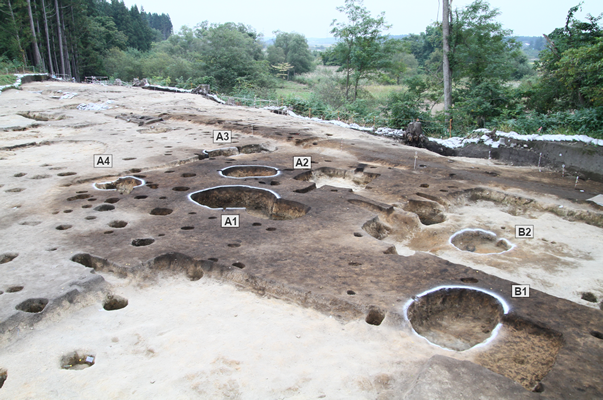
Panoramic view of the groups of pit burials (from the northwest) The features outlined in white are pit burials. The four at the left and to the rear are Group A, and the two at right front are Group B. Two different types of burials are grouped together within a narrow area with a radius of roughly 6.5 m. The difference in elevation with the alluvial area visible to the rear is approximately 8 m.
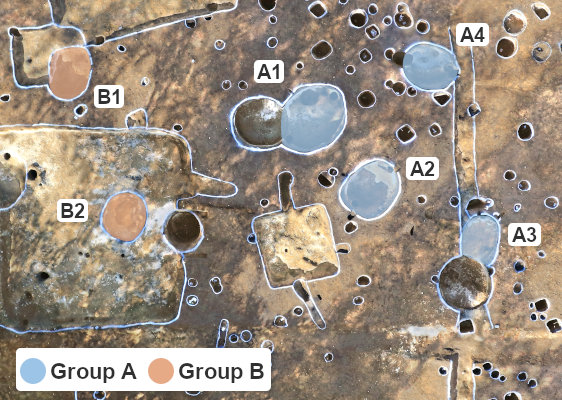
Distribution of pit burials The vicinity is overlapped with Heian period pit-structures and pits, and Early Modern embedded-pillar buildings and wells, etc. Adapted from Hakkutsu sareta Nihon rettō 2022 [Excavations in the Japanese Archipelago, 2022] (Bunkachō [Agency for Cultural Affairs], ed., Kyodo News, 2022).
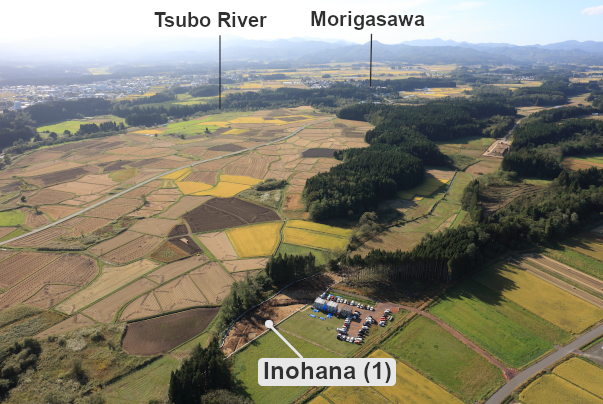
Distant view of the Inohana (1) site (from the east) The Morigasawa site is visible at a point 1.5 km to the west. Adapted from Hakkutsu sareta Nihon rettō 2022 [Excavations in the Japanese Archipelago, 2022] (Bunkachō [Agency for Cultural Affairs], ed., Kyodo News, 2022).
Group A pit burials and grave goods
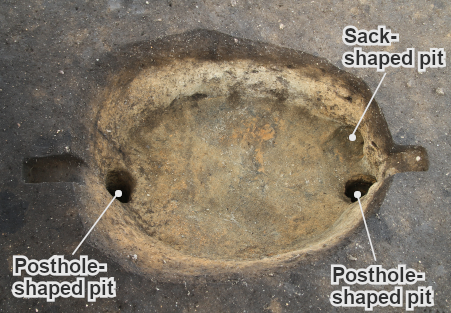
Pit burial A2 Posthole-shaped pits are visible at both ends of the long axis, and a sack-shaped pit is seen above the posthole-shaped pit on the right. It is inferred that a shelter was set on pillars standing in the posthole-shaped pits, and that grave goods were placed in the sack-shaped pit. In Epi-Jōmon culture pit burials of Hokkaido at this time, human skeletons were mostly flexed and laid horizontally. Long axis of the pit-burial: 162 cm. Adapted from Hakkutsu sareta Nihon rettō 2022 [Excavations in the Japanese Archipelago, 2022] (Bunkachō [Agency for Cultural Affairs], ed., Kyodo News, 2022).
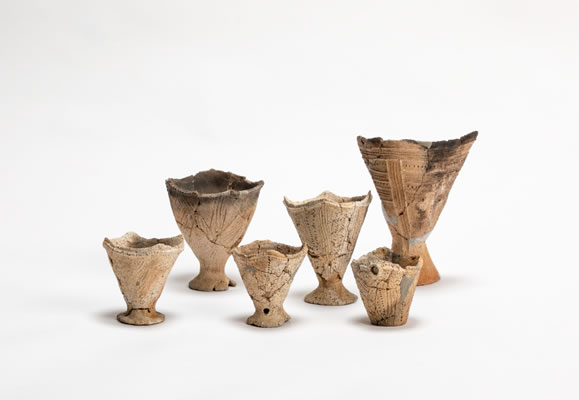
Epi-Jōmon pottery recovered from burial A1 Small-scale items are thought to have been made for use as grave offerings. The large items have soot that adhered from actual use in daily life or from acts of boiling during funerary rites. Height of item at far right, back row: 16.9 cm.
Group B pit burials and grave goods
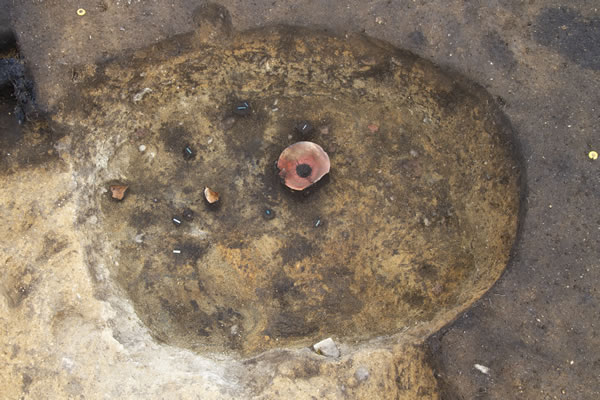
Pit burial B1 A red-painted pedestalled dish of early Haji ware and beads were found. Only the dish was found, with the pedestal recovered from pit burial B2. Long axis of the pit-burial: 152 cm.
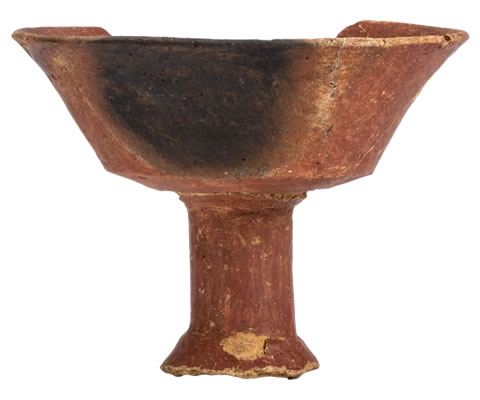
Pedestalled dish recovered from pit burials B1 and B2 The dish portion was recovered from B1, and the pedestal from B2. Surviving height: 13.8 cm.

Beads recovered from pit burial B1 Cylindrical beads made of jasper, green volcanic tuff, and steatite; a biconical jasper bead; and round amber beads were found. Adapted from Hakkutsu sareta Nihon rettō 2022 [Excavations in the Japanese Archipelago, 2022] (Bunkachō [Agency for Cultural Affairs], ed., Kyodo News, 2022).
Epi-Jōmon Period and Epi-Jōmon Culture
In Honshu, Shikoku, and Kyushu, following the Jōmon is the start of the Yayoi period, in which paddy rice cultivation was the main livelihood, but in the colder region centering on Hokkaido rice cultivation did not take hold, and a way of life focused on hunting, gathering, and fishing continued from the Jōmon period. This is called the “Epi-Jōmon period,” and its livelihood and culture the “Epi-Jōmon culture.” In the northern part of the Tōhoku region starting with Aomori Prefecture, while the chronological divisions of the Yayoi and Kofun periods are utilized, a complex situation of the intermingling of Epi-Jōmon with Yayoi and Kofun cultures is recognized.
A place for north–south exchange where Epi-Jōmon and Kofun culture intermingled
Two types of pit burials
For the Kofun period of northern Tōhoku (Aomori, Iwate, Akita Prefectures), there are many unclear points especially for the start of the era, and a state that could even be called a “historical vacuum” has long persisted. However, with the results of the investigation at the Inohana (1) site located in the town of Shichinohe in Aomori, it has been learned that the area of Aomori Prefecture in the Early Kofun period was a region where the Epi-Jōmon culture advancing southward from Hokkaido intermingled in complex fashion with the Kofun culture moving north from southern Tōhoku and further south.
The Inohana (1) site is located in the eastern portion of Aomori Prefecture, on the edge of a tableland of around 20 m elevation in the middle reaches of the Tsubo River, which flows from the eastern slopes of Mount Hakkōda into Lake Ogawa. Excavation was conducted in 2018 and 2019, and six pit burials of the Early Kofun period were found.
While all of these pit burials were oval in their horizontal outlines, they were divided into two types: four burials (Group A) with “posthole-shaped pits” and a “sack-shaped pit” characteristic of Epi-Jōmon culture, and two burials (Group B) which lacked these features. From the Group A burials, early Haji ware of Kofun culture, iron implements, small glass beads and so forth were recovered along with Epi-Jōmon pottery, while the Group B burials yielded early Haji ware and various types of beads, etc. Examining these two types of burials in combination with their recovered artifacts, those of Group A are seen as having elements of both Epi-Jōmon and Kofun culture mixed together, while elements of Kofun culture are stronger in those of Group B.
Exchange between people having different cultures
Epi-Jōmon culture burials accompanied by posthole-shaped and sack-shaped pits have been discovered previously at sites such as Samukawa II in Noshiro City, Akita Prefecture, and Eifukujiyama in Morioka City, Iwate Prefecture, but no burials like those of Group B at Inohana (1) were found at those sites. Further, while most of the Epi-Jōmon pottery at the Inohana (1) site thought to have been for offerings showed influence from early Haji ware of the Kofun cultural sphere, the early Haji ware itself did not consist of items brought from regions of Kofun culture, but are understood as possibly having been of local manufacture. It may be surmised from this that elements of Epi-Jōmon culture and Kofun culture had fused together and taken root in this area.
Also, from the inclusion of rare beads such as biconical items of jasper and round amber beads perhaps brought from the north, it is possible that the people buried included powerful figures of this region. While they are from different periods, nearby this site is the Middle Yayoi period site of Funabamukai Kawakubo (2) where 137 narrow cylindrical beads were recovered, and the Middle Kofun period site of Morigasawa where beads were recovered from 17 out of 20 pit burials. A lineage of powerful individuals who were able to obtain rare beads can be glimpsed.
From the current discovery, it has been learned that with hardly any interval from the start of the Kofun period, elements of Kofun culture had reached the area of Aomori Prefecture at the northern tip of Honshu. The vicinity of the Inohana (1) site appears to have been a locus of exchange between cultures of the north and south, where bearers of these different cultures mingled. In the future, research is anticipated on the manner of acceptance of Kofun culture by those residing locally, and the reasons why people of Kofun cultural lineage advanced northward. (Kimura Takashi)

